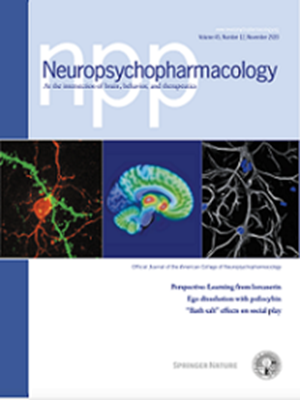Targeting depression circuitry with H1 coil Transcranial Magnetic Stimulation: a retrospective circuit mapping study
IF 6.6
1区 医学
Q1 NEUROSCIENCES
引用次数: 0
Abstract
The efficacy of transcranial magnetic stimulation (TMS) for depression may depend on targeting specific brain circuits. However, this has not been tested for TMS with the H1 coil, a widely used device believed to target more broadly and deeply than TMS with figure-of-8 coils. This study examined whether targeting a specific brain circuit with H1 coil TMS treatment may impact depressive symptom improvement. We retrospectively analyzed data from 97 patients at McLean Hospital, who received at least 19 TMS sessions and had incidentally completed an anatomical brain MRI. We modeled each patient’s electric (E-)field using SimNIBS and estimated the connectivity of the E-field using a normative connectome (n = 1000), which was correlated with depression improvement as measured by the Quick Inventory of Depressive Symptomatology. H1 E-fields improving depression were preferentially connected to a distinct brain circuit, validated with leave-one-out cross-validation (p = 0.0005). This circuit was significantly similar to a predefined causal depression circuit (spatial r = 0.59, p = 0.04) derived from TMS, deep brain stimulation, and lesion studies. E-fields with greater connectivity similarity to this circuit led to greater symptom improvement (r = 0.41, p < 0.001). Post-hoc analyses revealed that more posterior coil positioning increases H1 E-field overlap with the depression circuit, with high overlap at scalp locations 3–6 cm anterior to the motor hotspot. Thus, H1 coil stimulation sites that improve depression converge on a common causal depression circuit. Prospective studies are needed to validate these findings.

用H1线圈经颅磁刺激靶向抑郁回路:一项回顾性回路测绘研究。
经颅磁刺激(TMS)治疗抑郁症的疗效可能取决于针对特定的脑回路。然而,这还没有在H1线圈的经颅磁刺激中进行测试,H1线圈是一种广泛使用的设备,被认为比8形线圈的经颅磁刺激更广泛、更深入。本研究考察了针对特定脑回路的H1线圈TMS治疗是否会影响抑郁症状的改善。我们回顾性分析了麦克林医院97例患者的数据,这些患者接受了至少19次经颅磁刺激,并附带完成了脑解剖MRI。我们使用SimNIBS对每位患者的电(E)场进行建模,并使用标准连接组(n = 1000)估计E-场的连通性,这与抑郁症状快速清单测量的抑郁改善相关。改善抑郁的H1电场优先连接到一个独特的脑回路,用留一交叉验证(p = 0.0005)进行验证。该回路与经颅磁刺激、深部脑刺激和病变研究得出的预先确定的因果抑郁回路(空间r = 0.59, p = 0.04)显著相似。与该回路连接性相似度更高的电场导致症状改善更大(r = 0.41, p
本文章由计算机程序翻译,如有差异,请以英文原文为准。
求助全文
约1分钟内获得全文
求助全文
来源期刊

Neuropsychopharmacology
医学-精神病学
CiteScore
15.00
自引率
2.60%
发文量
240
审稿时长
2 months
期刊介绍:
Neuropsychopharmacology is a reputable international scientific journal that serves as the official publication of the American College of Neuropsychopharmacology (ACNP). The journal's primary focus is on research that enhances our knowledge of the brain and behavior, with a particular emphasis on the molecular, cellular, physiological, and psychological aspects of substances that affect the central nervous system (CNS). It also aims to identify new molecular targets for the development of future drugs.
The journal prioritizes original research reports, but it also welcomes mini-reviews and perspectives, which are often solicited by the editorial office. These types of articles provide valuable insights and syntheses of current research trends and future directions in the field of neuroscience and pharmacology.
 求助内容:
求助内容: 应助结果提醒方式:
应助结果提醒方式:


